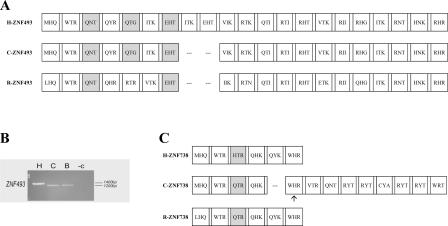Figure 5.
Zinc finger exon analysis for ZNF493 and ZNF738, two divergent genes from the ZNF431 clade. The alignments include the human predicted proteins and their orthologs determined from the chimpanzee and rhesus genomic data. Finger boxes, amino acid codes, predicted frameshifts, and degenerate finger shading are as in Figure 4B. The alignment for the predicted ZNF493 proteins (A) shows that the human version has two additional zinc finger motifs compared with both its chimpanzee and rhesus orthologs, indicating the change is an addition of fingers in the human. (B) The relative sizes of ZNF493 zinc finger exon PCR products from genomic DNA of human, chimpanzee, and bonobo is consistent with the human/chimpanzee difference in finger number; species designations are as in Figure 4A. (C) The chimpanzee ZNF738 protein’s differences with the human version, based on draft genomic sequence, include a deleted finger motif, a substitution that eliminates the stop codon seen in human, and a possible frameshift after the deleted finger. Although these differences have not been confirmed, any would change the predicted translation of the chimpanzee protein compared with the human ortholog.

